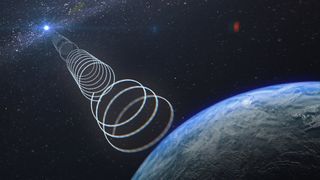Mysterious 'cosmic burpers' are shooting out bizarre radio waves from extragalactic nebula's meat

Astronomers studying the central region of the Milky Way System bear discovered a freshly author of cosmic radio waves so bizarre that they are troubled to ideate what charitable of targe could make up sending them out.
The radio waves vary in intensiveness, oscillate in only one direction, rotate over time, and randomly switch on and off with no discernable pattern, according to University of Sydney researchers, who published their data in a new study in the Astronomy Daybook.
"We've never seen anything like it," Ziteng Wang, a Ph.D. educatee at the University of Sydney and lead generator of the paper, said in a instruction.
"Ab initio we thought information technology could be a pulsar—a very dense eccentric of spinning dead star—or else a type of star that emits huge solar flares. Just the signals from this new source don't match what we require from these types of heavenly objects," Wang added.
Since the radio waves do not check any famous normal or informant, they could represent signals from a completely unknown class of object, but what that object might be is hard-fought to think disposed the bizarre nature of the signals themselves.
"Sounding towards the center of the Galaxy, we saved ASKAP J173608.2-321635, named after its coordinates," said Wang's Ph.D. supervisory program, University of Sydney professor Tara Murphy. "This object was unique in that it started unsuccessful invisible, became bright, faded away and past reappeared. This conduct was extraordinary."
The bizarre nature of this untried find doesn't mean information technology is only unparalleled, nonetheless. In recent years, astronomers have been finding that the creation is filled with radio waves that we are likewise just now being fit to detect.
"The data we do have [about the object] has some parallels with another emerging class of mysterious objects titled Galactic Centre Radio Transients, including one dubbed the 'cosmic burper'," aforesaid Wang's co-supervisor David Kaplan, a professor at the University of Wisconsin-Milwaukee.
"While our new object, ASKAP J173608.2-321635, does share some properties with GCRTs there are also differences," he added. "And we don't really infer those sources, anyway, so this adds to the secret."
- Astronomers finally solve the mystery of a famous 900-class-old Formosan supernova
- Elusive black hole just disclosed itself when it got caught snacking on a star
- James Webb Space Telescope finally gets a launch date
Psychoanalysis: radio astronomy opens finished new frontiers we didn't even know were on that point
Radio astronomy is a quickly growth speciality thanks to new radio telescopes that can buoy detect a broader cast of radio signals, making stars and other objects in the universe that might personify in effect nonvisual to us in the visible light discernable when viewed in the infrared or unseeable spectrums.
In recent years, all kinds of astronomical phenomena like supernovae and exotic objects alike sarcastic holes have been imaged using radio astronomy, including the 2022 image of the supermassive black hole M87 at the essence of the galaxy, the foremost ever pictur of its benevolent.
With new telescopes forthcoming online in the coming years, like the James Webb Telescope we expect to supersede the Hubble Telescope when IT launches toward the end of 2021, even more of the universe will be accessible in ways we are simply just beginning to realize.
"Inside the next decade, the transcontinental Square Kilometre Range radio reflector will come online," Professor Murphy said. "IT will be healthy to make sensitive maps of the sky every day. We expect the power of this telescope will avail us solve mysteries so much as this latest find, simply it will too open vast novel swathes of the creation to geographic expedition in the radio spectrum."
- Supernova shoots a demise genius made of gold-bearing out of Milky Way at 2 one thousand thousand miles per hour
Mysterious 'cosmic burpers' are shooting out bizarre radio waves from galaxy's core
Source: https://www.techradar.com/news/mysterious-cosmic-burpers-are-shooting-out-bizarre-radio-waves-from-galaxys-core
